2010 Volkswagen Golf – Click above for high-res image gallery
Outside of North America, the Golf has been Volkswagen's bread-and-butter model for more than three decades, making the diminutive hatch one of the best selling global vehicles since its mid-Seventies launch as the Beetle's successor. But in the States, it's a totally different story. Except for a few brief periods when fuel prices spiked, the Golf/Rabbit has always played second fiddle to the Jetta – little more than a Golf with a trunk.
While the sixth generation Golf has been on sale in Europe for nearly a year, U.S.-spec versions are beginning to trickle into retailers on this side of the Atlantic. But before you head down to your local V-Dub dealer to check out the newest Golf (and buy a Jetta instead), we made the trek to Germany to sample the latest iteration of VW's workhorse in and around its Wolfsburg birthplace. Is the new Golf finally enough to woo hatch-averse Americans out of their sedans and into something with an added helping of practicality? Follow the jump to find out our first impressions.
Photos copyright ©2009 Sam Abuelsamid / Weblogs, Inc.
Heading into 2010, Volkswagen of America is killing off the Rabbit name for the second time in the hatch's history. The MkI was originally dubbed the Rabbit in North America because the corporate mothership felt U.S. buyers wouldn't understand the European "Golf" moniker. By the time the MkII arrived, VW switched over to the global nameplate, only to reverse course with the last generation MkV, reviving the cuddly name in an attempt to rekindle nostalgia and spur flagging sales. It didn't work, so the Golf is back... hopefully for good.
The MkVI isn't quite an "all-new" vehicle – it's more of a MkV.5, retaining the last generation's platform and at least half (two-thirds if you include the GTI) of the powertrain lineup. The most obvious revisions are on the outside, with none of the previous generation's bodywork carrying over to the MkVI. We're good with that, and Walter de Silva, Volkswagen Group's head of design, is understandably proud of his latest creation.
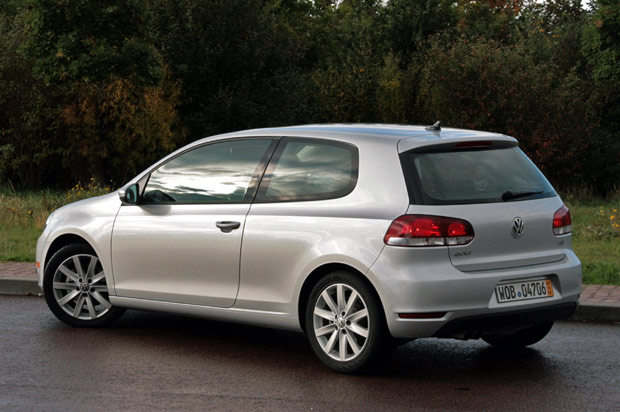
De Silva discussed VW's styling strategy going forward, emphasizing the automaker's decision not to go retro, but rather incorporating elements that show a connection to the past. One of those themes is a horizontal emphasis in the grille that hearkens back to the original, rectilinear Giugiaro-designed model. De Silva maintains that a Volkswagen should evoke simplicity, solidity and robustness, noting that, "the period of over-design is finished."
We asked Klaus Bischoff, head of design for the VW brand to elaborate, noting that the last generation model's vertical, chrome laden face that infiltrated most of VW's North American line-up, always came across as overwrought for a VW. While Bischoff wouldn't go that far, he did concede that it never fit with the intended image of the brand and was perhaps too similar to the grille found on VW's corporate cousin, Audi.
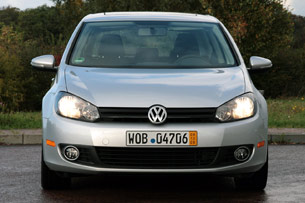
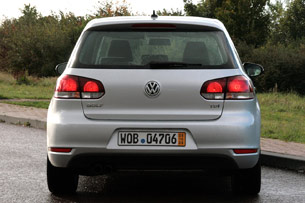
The resulting redesign has created one of the most attractive Golfs in the automaker's history, with the front fascia adopting a more subdued, Scirocco-inspired grille and headlamps, while the tail lights and rear bumper have been reworked to reflect VW's new softened aesthetic, conjuring up a bit of the MkI in the process. Along the flanks, the more pronounced character line and wheel arches give the hatch a more muscular look, yet it remains instantly recognizable as a Golf, just slightly evolved and more grown-up.
The 2010 Volkswagen Golf is available in two variants for North America: The base model's 2.5-liter five-cylinder gasoline engine carries over, while the Golf TDI makes its triumphant return equipped with the same 2.0-liter oil-burner that debuted in the Jetta TDI last year. We had the opportunity to pilot both models while in Germany, although we spent more time at the helm of the TDI than the gas-powered five-cylinder, which proved to be yet another eye-opening experience.
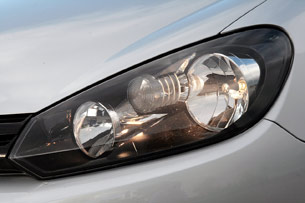
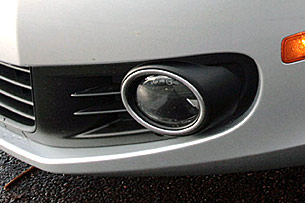
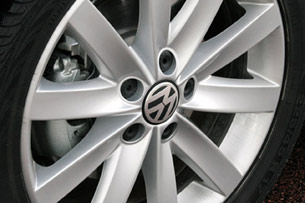
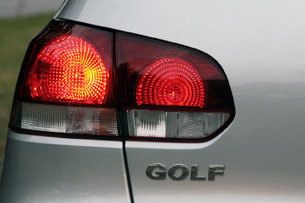
When the Jetta TDI debuted last year, VW hid some of the diesel's price premium by equipping the sedan similar to the middle-level SE trim level of the gas models. The same strategy is being used with the Golf, although this time around the lineup is simpler, with only the base and TDI trims and no gas models priced above the diesel. As such, the TDI comes equipped with standard fog-lamps, while the 2.5-liter gas model makes due with blank plates, and the TDI rolls on attractive, ten-spoke 17-inch wheels, compared to the 15-inch steelies fitted to the standard Golf.
One of Volkswagen's hallmarks has been its thoughtful, well-crafted interior. Even the cheapest entry-level Golf is equipped with quality of materials, with fit and finish easily a cut above its class. Of course, when you consider the price premium the average V-Dub commands, it should be a nice place to spend time, and VW consistently delivers. Nearly all the materials inside the MkVI feel durable, soft and pleasurable to the touch, with visible seams kept to a bare minimum.
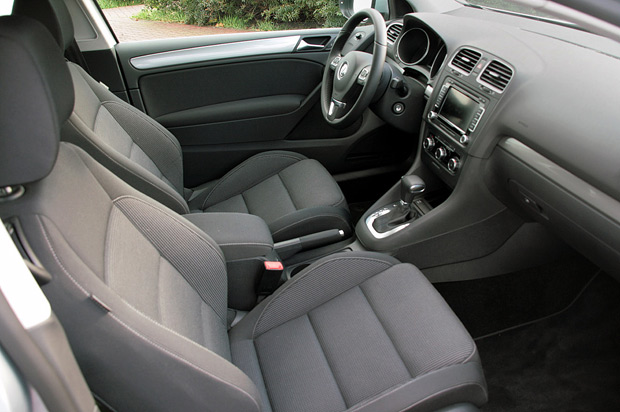
The design and layout of the new Golf's interior is a natural evolution of the previous model, but there's nothing wrong with that. Change for the sake of change doesn't necessarily make anything better, and with the Golf, the ergonomics are as superb as before, with nearly everything exactly where you expect it. The standard three-knob (fan speed, air location and temperature) climate control system anchors the center stack, with the entertainment system – available with a sat-nav setup – mounted above providing simple round dials for volume and tuning.
Here again, the gas and diesel models diverge with the oilburner offering a more upscale look and extra amenities to go with its more efficient engine. The gas Golfs get a basic AM/FM radio with a single disc CD player, while the pricier TDI gets a standard touch screen-based audio system with satellite radio and six-disc in-dash CD changer. Other features, like Bluetooth and a media device interface, are also bundled into the more expensive TDI, and for the directionally challenged looking for an integrated factory navigation system, the TDI is your only choice.
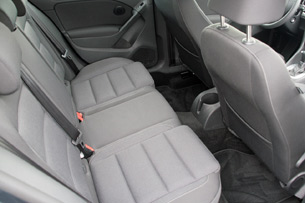
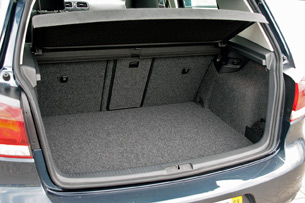
The front seats have basic adjustments for movement fore-aft, height, lumbar and back angle, while the driver enjoys a power adjuster for the seat back angle, while the passenger is relegated to the loved (by Germans, at least) rotary knob at the hinge. Both front seats have surprisingly ample side bolsters that help keep the driver planted directly in front of the steering wheel and all seats are swathed in cloth regardless of the powertrain choice.
Over two days, we drove a variety of U.S.-spec Golfs equipped with either the gas or diesel engines, and manual and Dual Sequential Gearbox (DSG) transmissions. For 2010, all Golfs get six forward ratios regardless of the shift mechanism, and those who opt for the petrol five-pot and DSG will have to pop the shift lever over to the right, then tap forward and back in order to manually select ratios, while TDI models with the DSG benefit from a set of steering wheel mounted paddle shifters.
Saddled into a two-door DSG for our run to the track, we quickly realized that VW continues to improve the behavior of the dual clutch gearbox. Some earlier examples occasionally felt sluggish when launching from a stop, but the latest edition never failed to pull away as smoothly as any torque converter automatic regardless of fuel type.
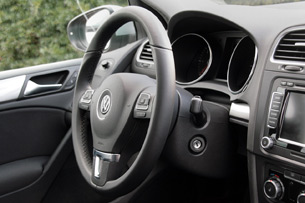
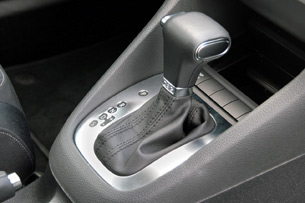
Maneuvering through Wolfsburg, the behavior of the gearbox was absolutely seamless. Despite our preference for three-pedal cars, the sub-5,000 RPM red-line of the diesel actually makes the self-shifting box the perfect traveling companion. The narrow power band proved effortless thanks to ample torque from the diesel, making both smooth launches and lugging along in second or third gear a breeze. The addition of the paddles are welcome when you want to take control of the propulsion process, and compared to the very similar Audi A3 TDI we drove several months back, this new Golf's powertrain felt superior in all conditions. We can only hope that the production U.S.-spec A3 is as good when it arrives later this year.
Another area where the TDI differs from the base model is its suspension and tires. All Golf TDI models come standard with a sport suspension package and the aforementioned plus-one wheels, giving the Golf a slightly crisper feel than the base model. However, both models exhibit the solid composure that we've come to expect from German-bred vehicles, a fact clearly demonstrated when we passed large trucks on the autobahn at triple digit speeds and felt nary a shudder or wiggle in their wake. One might expect a suspension capable of keeping body motions in check on smooth German highways would come across as stiff when road quality deteriorates, but that's not the case with the Golf. When we encountered stretches of bumpy cobblestones in Dresden, even the sport suspension setup on the TDI proved to be well behaved and comfortable, which bodes well for some of the neglected roads the TDI will have to endure Stateside.
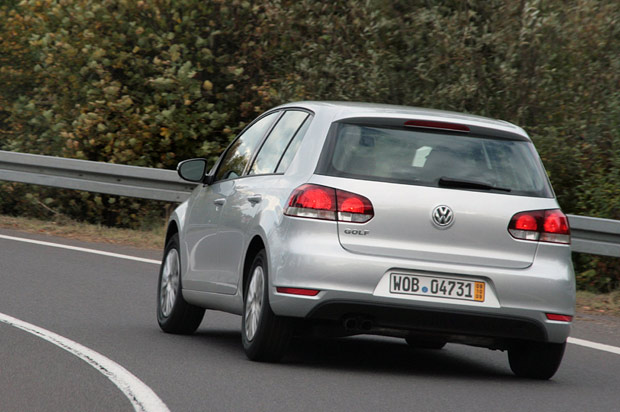
The Golf always tracked straight, even at speeds over 100 mph, aided by precise steering that made positioning a simple point and shoot affair. The steering provided adequate feedback when we had the chance to dive-bomb a few corners, a when the occasional delivery van became a rolling roadblock in the left lane, the Golf's brakes – while lacking in feel – were up to the task, easily reigning in the party from 115 to 60 MPH.
Since the diesel engine is the same unit that debuted last year in the Jetta, output remains unchanged at 140 horsepower and 236 pound-feet of torque, although both the gas and diesel models receive a few calibration tweaks for 2010 that boost miles per gallon on DSG models. The base, gas-powered five-cylinder engine puts out an adequate, if not inspiring, 177 hp, but its rough revving characteristics and lackluster fuel economy pale in comparison to the available oilburner. With any luck, VW will replace the five-pot with one of the TSI (turbocharged and direct injected) engines currently available in Europe. VWoA CEO Stefan Jacoby won't provided a timeframe as to when these stellar mills will make it to the U.S. market, but with displacement downsizing becoming more common, it's not a matter of if, but when. In the meantime, the quiet, smooth running diesel is easily the preferred powerplant for the Golf. Delivering a 0-60 MPH time of 8.6 seconds and flat torque curve, it's more than adequate for the vast majority of drivers and delivers fuel economy that could make most hybrids blush.
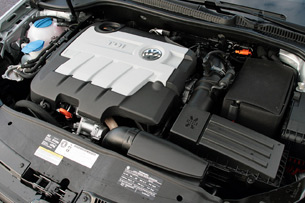
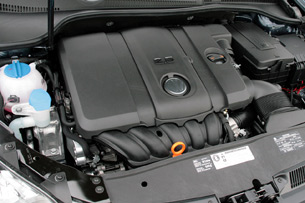
Cruising along at a steady 100 MPH, the trip computer was reading about 31-32 MPG (U.S.) or 7.4-7.5 L/100 km. On the run from Wolfsburg to Dresden, we saw an average of 37 MPG (U.S.) in a combination of urban and autobahn driving, including several triple digit stretches, while the gasoline version was hard pressed to enter the upper 20-MPG range. The EPA has already rated the Golf TDI at 30 MPG around town, with the manual getting 41 MPG on the highway and the DSG coming in at 42 MPG.
Volkswagen faces two problems with marketing the Golf in the U.S. market. The first, as we already mentioned, is the long-time resistance to hatchbacks among American buyers. That may be changing as hatchbacks begin to shuffle off their low budget, utilitarian demeanor. The second problem is more intractable. While VW builds the Jetta in Mexico, the Golf continues to be sourced from Germany. With the U.S. dollar currently trading at around $1.50 to the Euro, it's difficult for VW, or any European automaker, to turn a profit on lower end cars like the Golf. That's why the three-door, gas-engined Golf starts at nearly $17,500 and its MSRP tends to skyrocket as the option boxes are ticked.
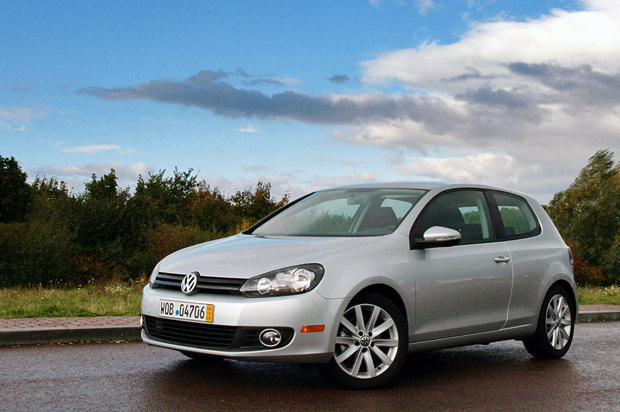
Volkswagen's new factory in Chatanooga, TN will help alleviate some of these issues in the mid-size market when it starts building a replacement for the Passat in mid-2011. According to VW of America CEO Stefan Jacoby, the site has sufficient space to double the initial size of the factory and produce up to 500,000 vehicles annually. VW also intends for Chatanooga products to have over 85 percent domestic content by value, and if demand warrants, VW could build the Golf in Tennesse at a more competitive cost.
For now, you'll have to swallow hard to step into a Golf over one of its market competitors. If you don't choke on the price, the new Golf has plenty to offer, especially when it comes to vehicle dynamics and utility. The base model isn't inexpensive, but it doesn't feel cheap. And for our money, we'd choose the excellent efficiency, increased amenities and superior suspension dynamics of the TDI -- until VW decides Stateside consumers are ready for one of its highly efficient 1.4-liter gas engines.
Photos copyright ©2009 Sam Abuelsamid / Weblogs, Inc.
Our travel and lodging for this media event were provided by the manufacturer.

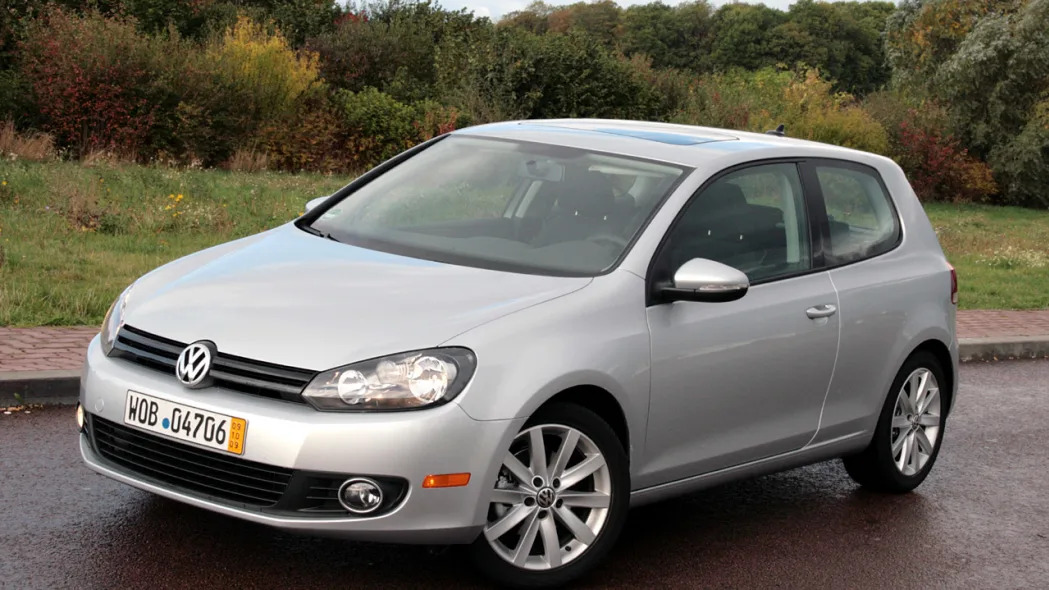

Sign in to post
Please sign in to leave a comment.
Continue